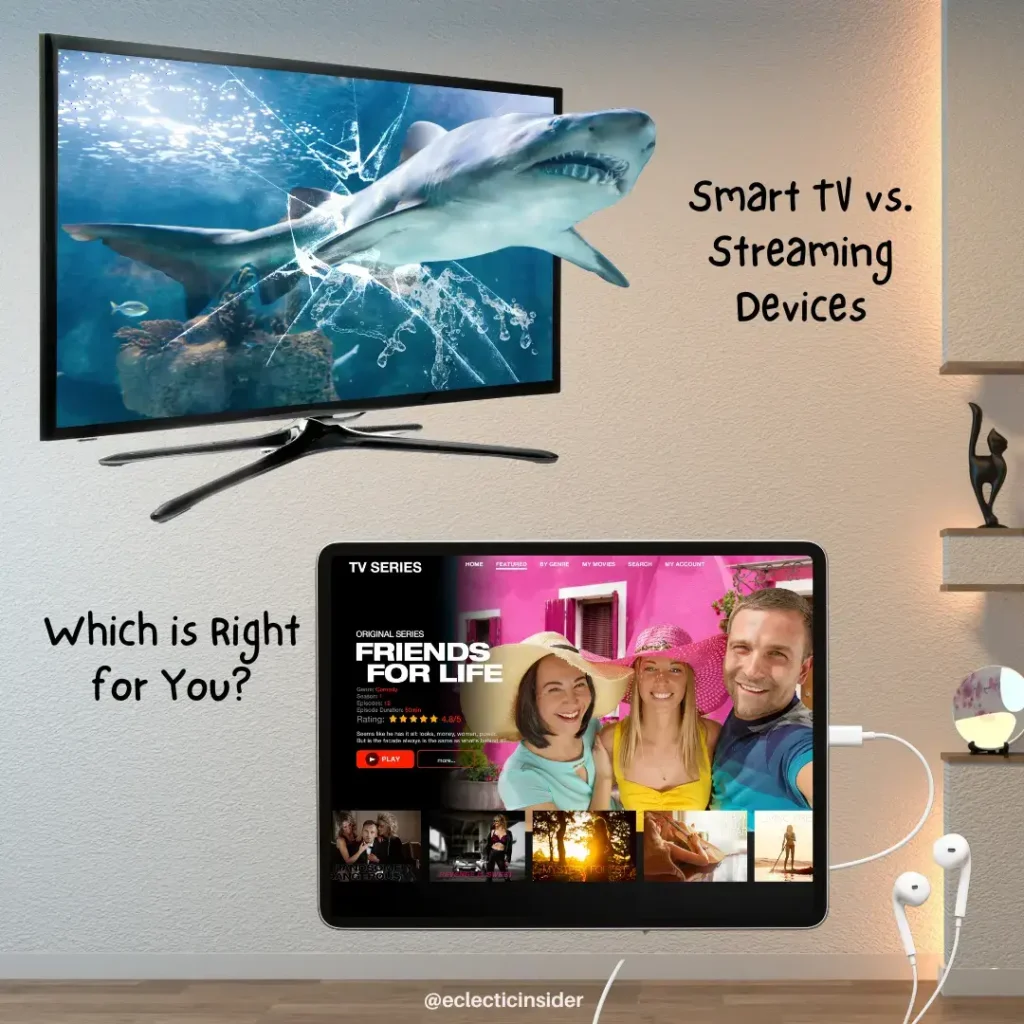In the age of streaming, the decision between a Smart TV and a standalone streaming device can significantly impact your entertainment experience.
Each option has its unique features, benefits, and drawbacks, tailored to different preferences and needs.

Smart TVs: All-in-One Convenience
Pros:
- Integrated Apps: Smart TVs come pre-loaded with popular streaming apps like Netflix, Hulu, and Disney+, making it easy to access content without additional devices.
- User Interface: They offer a unified interface where you can navigate between apps and traditional TV channels seamlessly.
- Voice Control: Many newer models support voice commands, allowing you to search for content or control playback hands-free.
- Home Integration: Smart TVs often integrate with smart home systems, letting you control lights, thermostats, and more from your TV.
Cons:
- Limited Updates: Older models may not receive software updates as frequently as standalone devices, potentially leading to outdated features or app compatibility issues.
- Performance Variability: Processing power and app performance can vary between different brands and models, affecting speed and responsiveness.
- Cost: Initial purchase prices can be higher compared to basic, non-smart TVs, especially for models with advanced features like 4K resolution or larger screen sizes.
Streaming Devices: Tailored Flexibility
Pros:
- Performance: Dedicated streaming devices often offer faster processors and more memory than built-in smart TV systems, leading to smoother navigation and quicker app loading times.
- Versatility: They can be easily moved between TVs, making them ideal for multi-room setups or upgrading older TVs without smart capabilities.
- App Availability: Some devices support a wider range of apps or services than smart TVs, including niche or international content not available on all smart TV platforms.
- Updates: Regular updates ensure compatibility with the latest apps and services, as well as ongoing performance improvements.
Cons:
- Additional Hardware: Requires an extra device and remote, which can clutter your entertainment setup and may involve additional costs.
- Interface Fragmentation: Using multiple devices for different streaming services can lead to a fragmented user experience, requiring switching between remotes and interfaces.
- Dependency on Wi-Fi: Relies on a strong Wi-Fi connection for streaming content, which may be affected by network congestion or range limitations.
Which is Right for You?
- For Seamless Integration: If you prefer simplicity and integration with other smart home devices, a Smart TV may be the best choice. It provides an all-in-one solution that reduces the need for additional hardware and simplifies your setup.
- For Performance and Flexibility: If you prioritize performance, flexibility, and future-proofing your setup, a standalone streaming device like Roku, Apple TV, or Amazon Fire Stick offers more robust features and frequent updates.
Conclusion
Ultimately, the decision between a Smart TV and a streaming device boils down to personal preferences, budget, and existing home setup.
Assess your streaming habits, desired features, and long-term entertainment goals to make the best choice for your viewing needs.
For more insights and recommendations on the 10 best Smart TVs available online on Amazon, check out our detailed guide to find the perfect fit for your home entertainment setup.
FAQs
What is the main difference between a smart TV and a streaming device?
A smart TV has internet connectivity and built-in apps for streaming, while a streaming device connects to your TV to provide smart capabilities.
Do smart TVs and streaming devices offer the same streaming services?
Generally, yes. Both can access popular services like Netflix, Hulu, and Amazon Prime Video, but availability can vary slightly based on the device and TV model.
Which offers better picture and sound quality, smart TVs or streaming devices?
Picture and sound quality can be similar, as both depend on the TV or device capabilities. High-end smart TVs and streaming devices both support 4K HDR and Dolby Atmos.
Are there cost differences between buying a smart TV and a streaming device?
Yes, smart TVs typically cost more upfront than streaming devices. However, streaming devices can be more cost-effective if you already have a TV.
Can streaming devices upgrade an older TV to have smart capabilities?
Yes, streaming devices like Roku, Apple TV, and Amazon Fire Stick can transform older TVs into smart TVs by adding streaming and app functionalities.
Do smart TVs offer more convenience compared to streaming devices?
Smart TVs integrate streaming services directly into the TV interface, reducing the need for additional remotes or devices, which can be more convenient for some users.
Which option is easier to set up and use, a smart TV or a streaming device?
Smart TVs are generally easier to set up initially since they require no additional devices. Streaming devices can be slightly more complex but offer flexibility and ease of use.
Do streaming devices receive updates and new features more frequently than smart TVs?
Yes, streaming devices often receive more frequent updates and new features since they are standalone devices designed to adapt to changing technology.
Can both smart TVs and streaming devices connect to other smart home devices?
Yes, both can integrate with smart home ecosystems, but compatibility may vary. Check device specifications for specific smart home integrations.
Which option is better for future-proofing your entertainment setup?
Streaming devices are generally easier to upgrade and replace as technology advances, making them more future-proof for accessing new streaming services and features.





